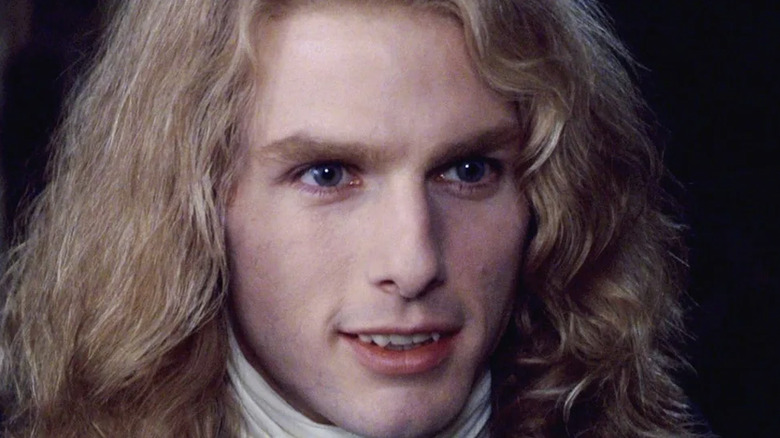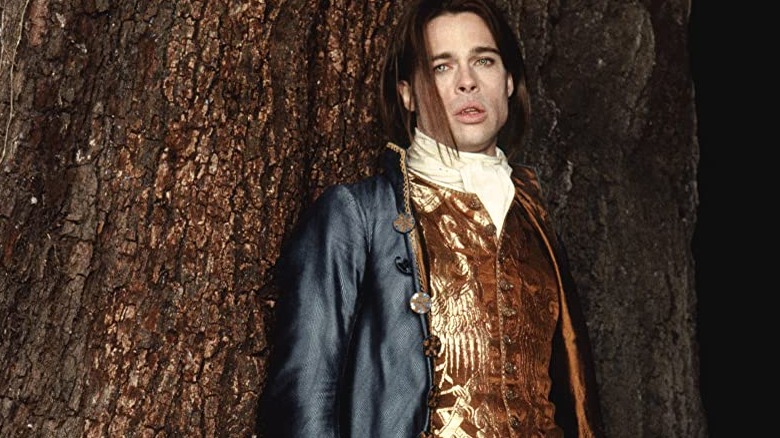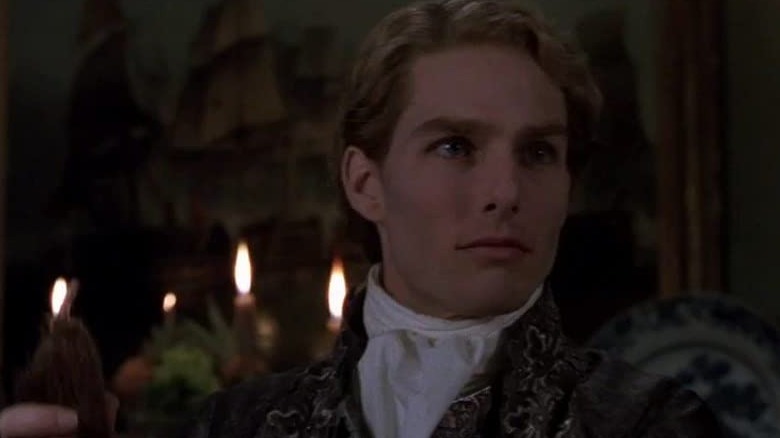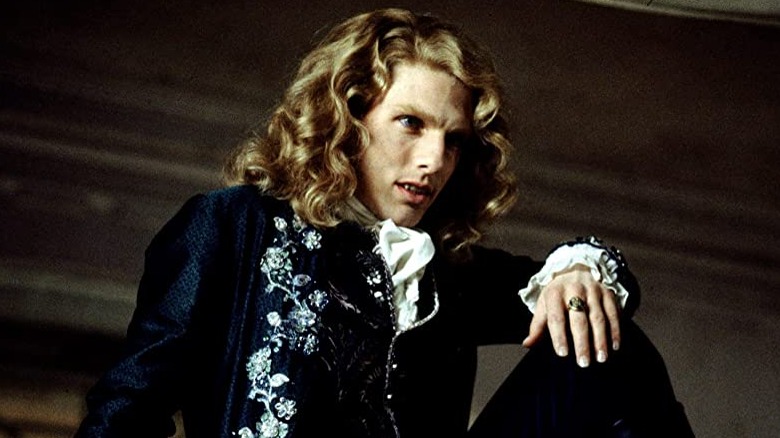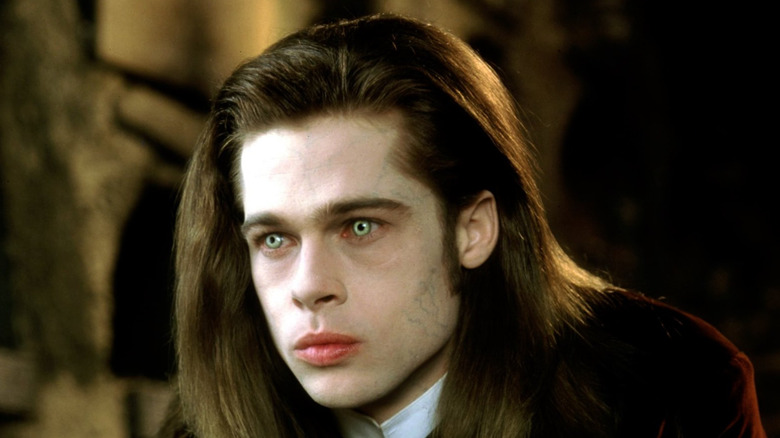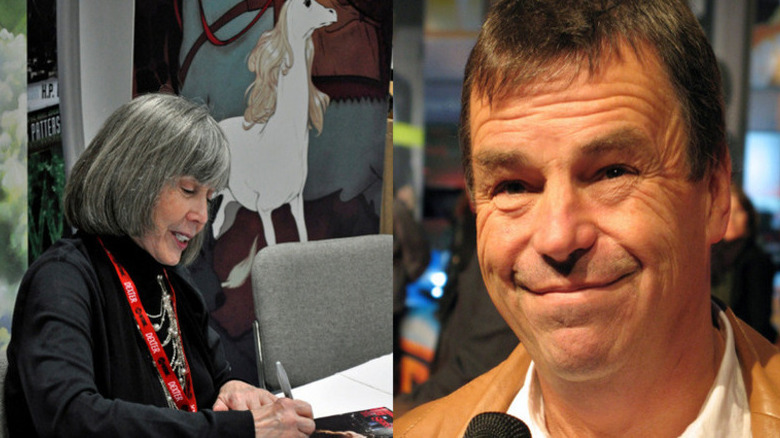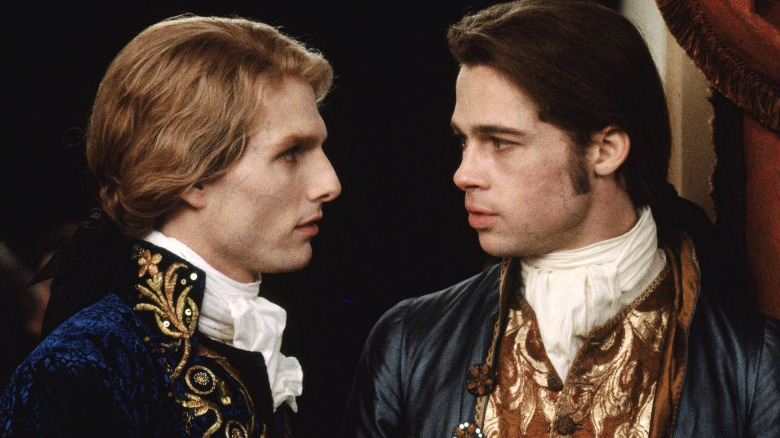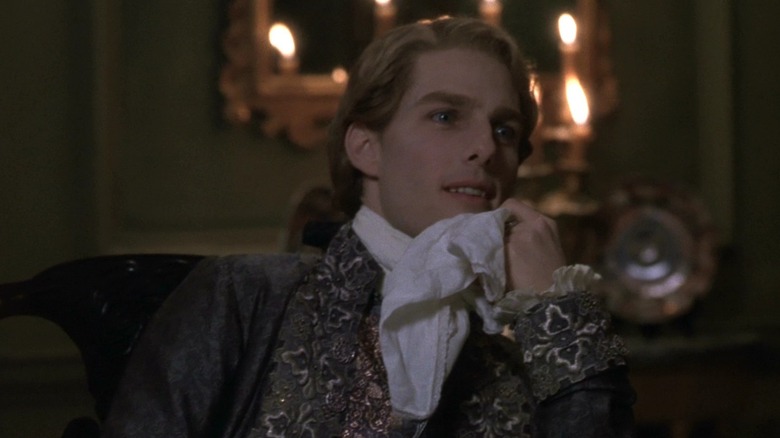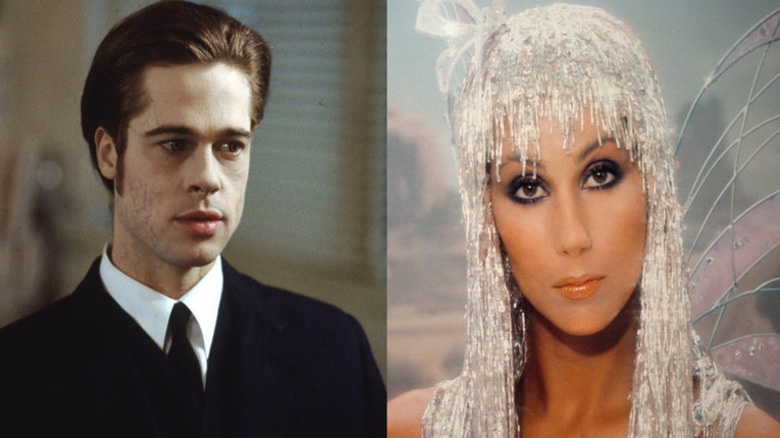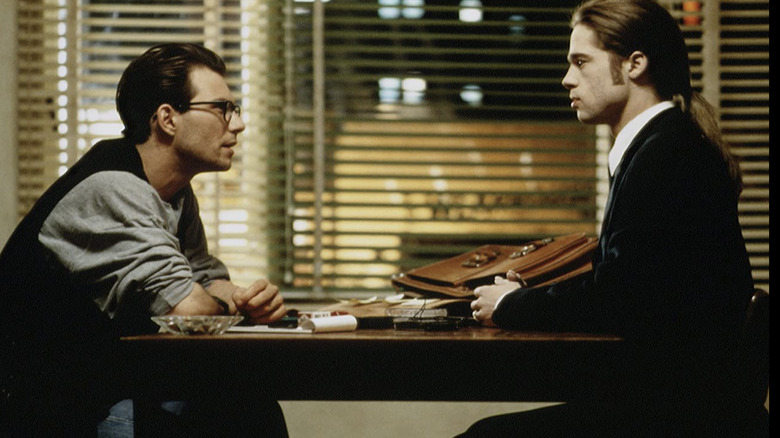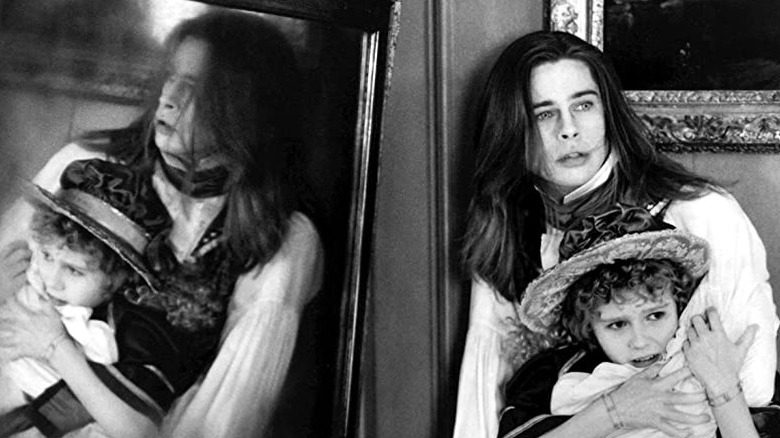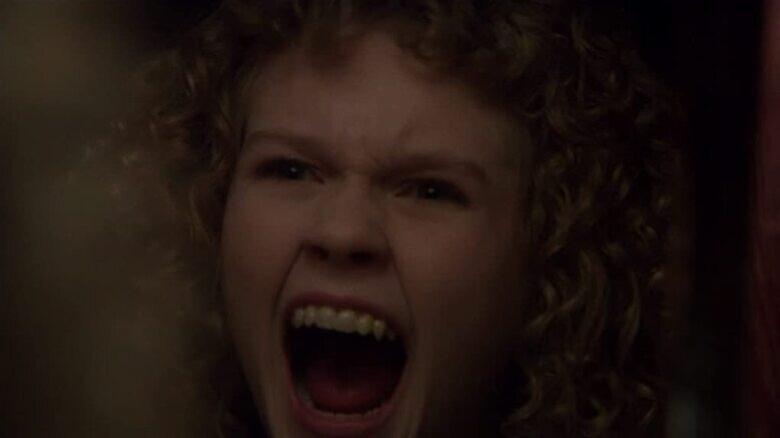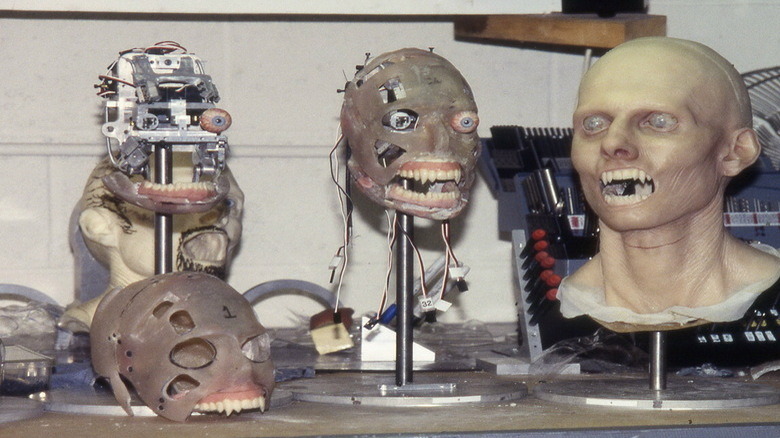The Untold Truth Of Interview With The Vampire
In the 21st century, you can't flip through three TV channels without coming across a vampire; back in the '90s, however, things were very different.
By the mid-90s, the vampire genre was scraping the bottom of its barrel, somewhere between pirates and Westerns. It had been decades since Dracula became a cinematic icon, and it would be many years until "True Blood," "The Vampire Diaries," "Twilight" and others would make bloodsucking cool again. But then a trifecta came to pass, one featuring a hit film (1992's "Bram Stoker's Dracula"), a critically-acclaimed film (1993's "Cronos"), and arguably the most eagerly-anticipated film of its year (1994's "Interview With the Vampire"). Of course, much of the progress these films made was undone by Eddie Murphy's 1995 bomb "Vampire in Brooklyn," but that's a story for a different article.
The fact of the matter is, good fang fests were hard to come by. Which is why, when "Interview with the Vampire" was optioned and Tom Cruise and Brad Pitt attached to a script by author Anne Rice herself, it seemed like a delicious prospect. Add in "The Crying Game" director Neil Jordan and a sumptuous, decadent couple hours was assured.
But things rarely turn out the way the world expects. From casting spats to rewrites and miserable actors, "Interview" barely made it to the screen at all. In the end, the film was indeed a hit, and as it approaches a milestone 30th anniversary, it is still so fondly remembered that it seems like the perfect time to look back on the film's top-secret details — some unsettling enough to make Lestat himself flash a pointy grin.
Make-upside down
However you feel about the casting, the level of gore, or the way the book was adapted, there's one thing everyone agrees on: The vampires (with the exception of Tom Cruise's hair) look great.
Oscar-winning makeup and special effects whiz Stan Winston captured the characters' vampiric essence. Weird glowy eyes? Check. Fangs that make talking even harder than usual for Brad Pitt? Check. But the piece de resistance of the entire vampire shebang has to be their delicately translucent skin.
If "Interview" was being made today, all that lovely vampiric stuff would most likely be CGI'd in during post-production. But this was the '90s, which meant hard contact lenses, fake fangs and painted-on veins. Winston came up with a truly unique method of ensuring that those delicate veins were accurate. Yes, accurate.
Believe it or not, every vein you can see on Brad Pitt and Tom Cruise's faces are actually their own veins. Winston (the late mastermind behind "T2," "Jurassic Park, "Aliens" and too many other classics to name) achieved this effect by making them hang upside down — a la David from "The Lost Boys" — for 30 minutes before starting the makeup process. Why? The rush of blood to the actor's head made their veins pop, allowing them to be more easily traced and painted.
Anne Rice didn't want Tom Cruise
Back in 1994, it was big news that Anne Rice was vehemently opposed to Tom Cruise portraying her beloved Lestat de Lioncourt. But the story of how Cruise did it anyway is one of Hollywood's more bizarre tales.
Rice originally sold the film rights to "Interview" back in the '70s. At the time, she had visions of Rutger Hauer or, somehow, John Travolta in the title role. Things can move exceptionally slowly in Tinseltown, however. By the time an adaptation finally got off the ground, both actors were considered too mature for the part.
Rice was far more interested in '90s possibilities like Jeremy Irons, John Malkovich and Tom Actual Hanks for the part. When the studio went with Cruise against her advice, Rice made her feelings known. To anyone who would listen.
Here's how she described Cruise's casting to the L.A. Times: "[Cruise] is no more my vampire Lestat than Edward G. Robinson is Rhett Butler."
She even went so far as to ask that Cruise and Brad Pitt just switch roles. But as Rice explained to Movieline in 1994, "They just don't listen to me."
Anne Rice came around
After having been so vocal in her opposition during production, Rice's opinions about Cruise did a complete 180 just in time for opening night. In fact, upon seeing the completed film that she dubbed a "masterpiece", the author seemed completely under the spell of Cruise's Lestat.
So contrite was Rice that she took out a full page ad in Vanity Fair to apologize. Decades later the author (who published her 13th "Vampire Chronicles" novel in 2018) was still attempting to explain her change of heart. In a 2009 interview, she reasoned: "I was too shocked at the beginning and I was very much against [Cruise's casting. But] I think Tom did a wonderful job, I really do."
"[Tom] got the essence of Lestat. He got Lestat's power," she continued. "He got his charisma and his charm. He got them all across in the movie ... he had great skill in that performance."
While for the most part audiences agreed, there was one very important viewer who wasn't impressed: Oprah. The '90s talk show titan hated "Interview" so much, in fact, that she walked out of a screening in the first ten minutes. She then almost cancelled a Cruise appearance on her show because of how bloody the film was, explaining: 'I believe there are forces of light and darkness in the world, and I don't want to be a contributor to the force of darkness." Tom Cruise did in fact appear on Oprah's show, offering up a four-word response: "It's a vampire movie!"
The shoot broke Brad Pitt and he tried to run away
Brad Pitt made no secret of the fact that he found the entire "Interview" experience deeply unsettling.
Years later, when an Entertainment Weekly reporter said he looked miserable during the shoot, he replied: "I am miserable. Six months in the f***ing dark, contact lenses, makeup ... London was dead of winter. We're shooting in Pinewood. There's no windows in there."
In 2011, he once again looked back on the experience with something less than enthusiasm. "You go to work in the dark. You go to this cauldron, this mausoleum, and then you come out and it's dark. One day, it broke me."
Having been pushed to his darkness/contacts/gravity boots limit, the star took decisive action. He told EW, "I called David Geffen, who was a producer. I said, 'I can't do this anymore. I can't do it. How much will it take to get me out?'
The actor went on, "[Geffen] goes, very calmly, 'Forty million dollars.'" So whether he liked it or not, Pitt stuck it out until the bitter end. And while he may have referred to the film as "the shoot from hell," he would add that it was "worth every minute of it. We got a great movie out of it."
Anne Rice wasn't the only screenwriter
Although Rice had written lots of versions of the script for "Interview" over the years, '94's was different. A little too different, in fact, as far as the author was concerned.
"I've had a good relationship with [producer] David Geffen, although it's kind of iffy right now," she told Movieline about ten months before the film's release. "When I was working on the script for 'Interview,' I told him I wanted to do exactly what I wanted to do with it. And that's the way I wrote it. [Director] Neil Jordan has rewritten it, and they are putting his name on the credits, and I don't know if you know, but the WGA will only allow a director to share writing credit if he brings over 50% original material. I don't know if he's done that or not. Maybe he has."
As it turns out, Jordan did not receive a writing credit, and Rice was the only credited writer on the final film.
Anne Rice posted her own extensive notes in 1994 on the movie and everyone involved, sounding as if she had largely forgiven Jordan for any transgressions and saw the film's final product as a success.
"Whatever Neil Jordan's comments to the press, he seemed to believe in that and to make it work on the screen," she wrote. "The film is one which the audience starts talking about, discussing, arguing before they ever leave the theatre. The film invites analysis. It invites a return viewing. It makes a difference to the people who see it."
Brad Pitt spent a lot of time in a ditch
As we all know, Tom Cruise is famous for many, many things. But being tall is definitely not one of them. As his success shows, though, height is no indicator of talent. Unless that is, you're playing a vampire that is six feet tall.
Since Pitt is 5'11" and Cruise is 5'7," the production team came up with some ingenious ways to balance out that not-so-subtle height discrepancy.
The simplest solution, it seems, was to put heels on Cruise's shoes. But as "Drag Race" had yet to be invented, having the star totter around in five inch heels just wouldn't have worked.
Which meant that other solutions — and a shorter heel — were necessary. So Cruise occasionally stood on specially-constructed platforms in scenes with Pitt. But then, production also came up with a third option.
They dug ditches, and Pitt stood in them while acting out scenes opposite Cruise. So, imagine one iconic Hollywood legend wearing platform shoes and the other standing in a ditch, and them both trying to act out impossibly dramatic moments while wearing fake pointy teeth and ponytails, and you have some idea of what was going on behind the scenes of "Vampire" on a daily basis. When you consider such things, it's amazing the film turned out as good as it did.
Cruise went Full Tom Cruise during pre-production
We all know that Tom Cruise can be a bit gung-ho when it comes to preparing for a role. Stunt work, aircraft piloting, so very much running ... the list is endless. But where "Interview" was concerned, Cruise found a whole new level of going for it.
The superstar saw Rice's savaging of his casting as a challenge. As he told Esquire at the time, "You don't usually start a movie with someone not wanting you to do it. That's unusual."
Describing his reaction to Rice's criticism, Cruise went on, "When it first hit, it really hurt, to be candid about it. Her venom hurt."
His way of dealing with that venom, it seems, was to do everything in his power to prove her wrong. To start with, he read all the books, saying, "You have to read [the source material] very carefully to find the clues to who Lestat is." He changed his diet and exercise regime to drop 12 pounds for the role. He moved to Paris. He even learned to play the piano. But perhaps the most useful — and deeply unpleasant — research involved watching film of lions hunting zebras in the wild. In Cruise's opinion, Lestat wasn't evil, he was merely amoral, hunting food to survive. He just wore a fabulous frock coat to do it.
Brad Pitt could have been Cher
Back in 1994, "Interview" was an envelope-pushing film. As it turns out, Rice wanted to push it even further.
During the movie's development, Rice and her editor, Vicki Wilson, hit on a radical plot twist: What if Louis was actually, say, Louise?
The pitch went something like this: Louis was in fact a woman dressed as a man, essentially a transvestite. Back in the dark ages, the film would explain, women couldn't own or run a business. So, to keep the plantation, she had taken on the persona and role of a man. Other than that small detail, Wilson told Movieline, "It was exactly the same as 'Interview with the Vampire'."
Who did Rice and Wilson have pegged for the newly-tweaked main role? None other than Cherilyn Sarkisian herself, Cher.
Given that the "Vampire Chronicles" TV show is about to be a reality, and the times we live in would seem to be more welcoming of such a twist, perhaps a gender swap of the character could still happen.
Christian Slater stepped in after the death of River Phoenix
With a production already beset by public animosity between writer, director and star, you'd think things had reached a nadir for the "Interview" crew. But, on October 31, 1993, River Phoenix's death at age 23 forced the production to scramble once again.
"We lost River. Literally a week before he was supposed to come in, he passed away," Pitt told EW in 2008. "It was a horrible moment."
Phoenix's passing meant that not only had the production lost a friend and colleague, they had also lost their Malloy, the reporter who conducts the eponymous interview. Which meant that someone had to take Phoenix's place.
During a 2008 chat with Venice magazine, Christian Slater admitted it was a difficult role to take, reflecting on the unease he felt at the time. "(Phoenix's death) was tragic ... It was really awkward to be stepping into that kind of scenario." He went on, "I think I eased my own discomfort by not accepting money and donating it to (Phoenix's) charities." The actor gave away his entire $250,000 salary to EarthSave and Earth Trust.
Kirsten Dunst thought kissing Brad Pitt was disgusting
To an army of loyal fans over the last several decades, the notion of kissing Brad Pitt might sound like a moment for life's highlight reel. But although Dunst's character Claudia looked like a ten-year-old girl, she was supposed to be nearly 40 years old — even though in real life, Dunst obviously was the former.
As it turned out, there needed to be a kissing scene between Dunst and Pitt — who at the time was 29. In 2013, she explained her repugnance to Bullet magazine.
"It was just a peck," Dunst reasoned. "I remember Brad would watch lots of 'Real World' episodes. He had this long hair. He was just a hippie-ish cool dude. Everyone at the time was like, 'you're so lucky you kissed Brad Pitt,' but I thought it was disgusting. I didn't kiss anyone else until I was 16, I think. I was a late bloomer."
Kirsten Dunst auditioned twice
These days, Kirsten Dunst is a confident, assured acting veteran. But back in 1994, things were a little different.
So different in fact, we could have seen a Claudia with the face of Anne Hathaway or Christian Ricci were it not for one very confident adult. Listening in on ten-year-old Dunst as she bombed her initial audition (he was sitting just outside the room), Dunst's acting coach persuaded her not to give up just yet. As she explained to Variety in 2016, "He knew I didn't nail it. And I walked out and he was like, 'No, you go back in there.'"
Apologizing to all present, the coach explained: "She didn't do what she can do." So, Dunst got a second chance to impress and went on to land the role. In the eyes of many, Dunst's work has become iconic, and it propelled her career to a new level — even if she wouldn't be able to watch "Interview" for several years. Because she was so young at the time, Dunst's parents banned her from watching the film.
Robotic Tom Cruise
Some might assume this section title refers to his acting — but in actuality, there was a robotic element to Tom Cruise's performance.
During Claudia's first attempt to rid herself of Lestat, she clumsily slashes his throat. He then proceeds to bleed excessively and, for some reason, melt. If you were assuming these were physical effects, you'd be partially right. None of it was CGI'd. But what you saw was also not Tom Cruise rolling around and melting during that scene.
The movie's $70 million budget included money for an animatronic Tom Cruise. It was built to have realistic-looking masks placed on it, sculpted to look like his face and melted at will. All these years later, if you want to play Stan Winston yourself, you're just one transaction away from your own Lestat latex mask — which would allow you to recreate the actor's grisly demise at your leisure.
